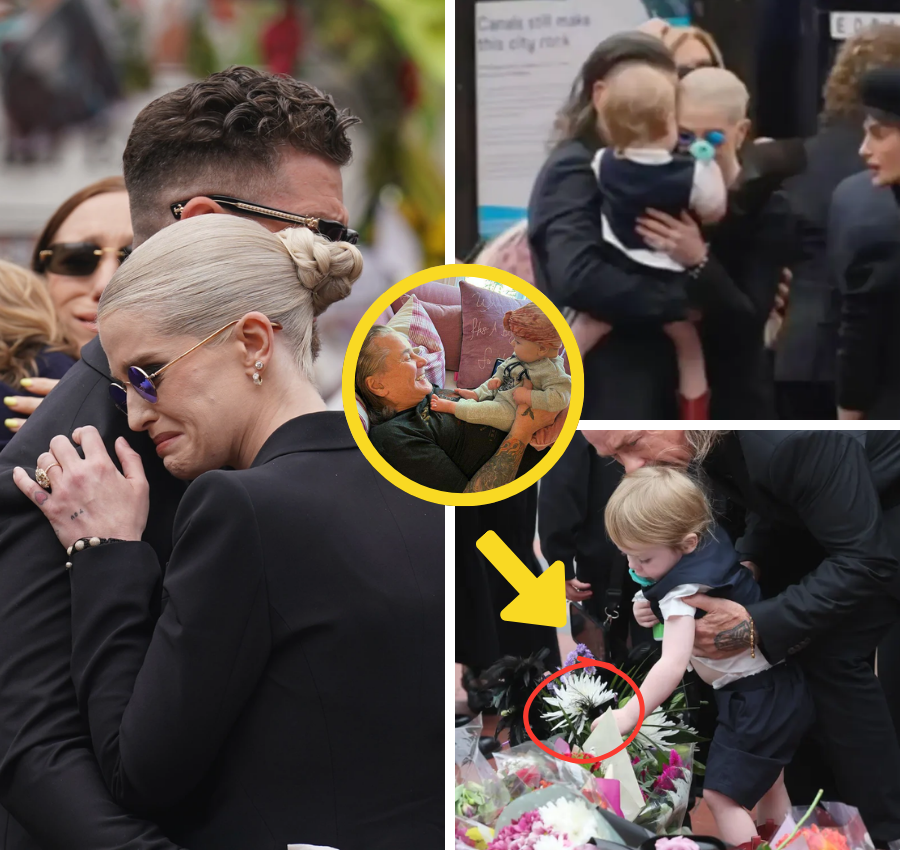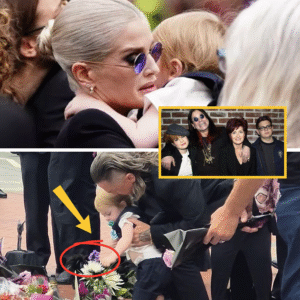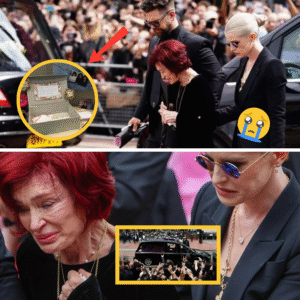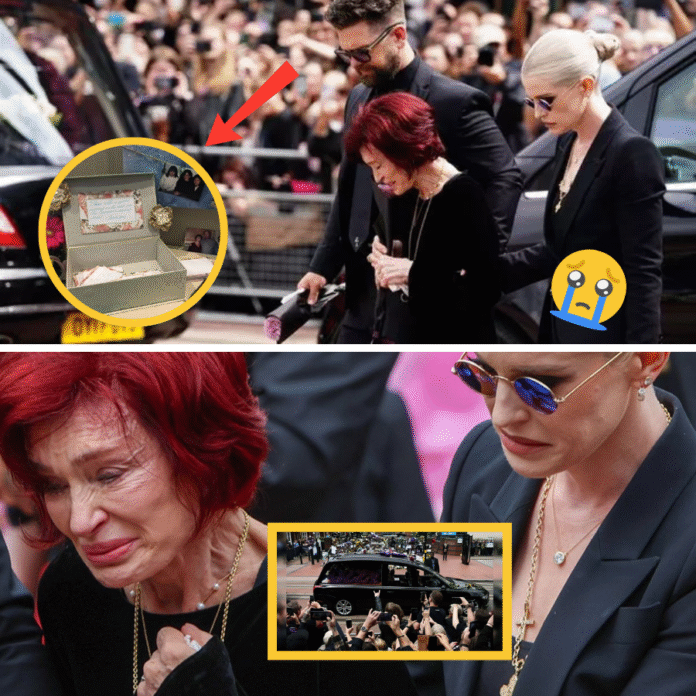“HE WANTED TO WALK ON HIS OWN FEET…” – Sharon Osbourne Reveals Why No One Carried Ozzy’s Coffin at Black Sabbath Bridge
On July 30, 2025, the streets of Birmingham, England, became a sea of purple and black as thousands gathered to honor Ozzy Osbourne, the legendary frontman of Black Sabbath, who passed away on July 22 at age 76. The funeral procession, a poignant tribute to the “Prince of Darkness,” culminated at Black Sabbath Bridge, a site symbolic of Ozzy’s roots and legacy. Amid the tears and tributes, a heartfelt detail emerged from Sharon Osbourne, Ozzy’s wife of 43 years, explaining why no one carried his coffin during the final leg of the procession. Her words, “He wanted to walk on his own feet…,” struck a deep chord with fans, encapsulating Ozzy’s indomitable spirit and sparking an emotional outpouring across the global heavy metal community.

A Final Journey Through Birmingham
The funeral procession began at Villa Park, where Ozzy performed his final concert, Back to the Beginning: Ozzy’s Final Bow, on July 5, 2025. The event saw Ozzy reunite with Black Sabbath bandmates Tony Iommi, Geezer Butler, and Bill Ward for a historic performance, despite his battle with Parkinson’s disease, diagnosed in 2019. The concert, attended by 42,000 fans and featuring acts like Metallica and Slayer, raised £140 million for charities, including Cure Parkinson’s and Birmingham Children’s Hospital. Ozzy, seated on a bat-themed throne due to mobility issues, delivered a spirited set, telling the crowd, “Your support has enabled us to live an amazing lifestyle, thank you from the bottom of our hearts.”
The procession traced a route through Ozzy’s hometown, passing his childhood home in Aston, where fans left flowers and balloons. The hearse, adorned with purple flowers spelling “Ozzy,” was accompanied by a brass band, Bostin’ Brass, playing renditions of Black Sabbath classics like “Iron Man” and “Paranoid.” Thousands lined Broad Street, chanting “Ozzy, Ozzy, Ozzy” and responding with “oi, oi, oi,” a nod to the call-and-response from his concerts. At Black Sabbath Bridge, a shrine of tributes since his death, the cortege paused, allowing Sharon, children Aimee, Kelly, Jack, and Louis, and fans to lay flowers and reflect.
Sharon’s Poignant Revelation

As the procession reached Black Sabbath Bridge, a striking detail stood out: unlike traditional funerals, no pallbearers carried Ozzy’s coffin. Instead, it remained in the hearse, which moved slowly as if guided by Ozzy’s own will. Sharon, tearful yet resolute, shared the reason in a brief statement to the crowd, captured by local media: “Ozzy always said he’d walk on his own feet, no matter how tough it got. Even now, he didn’t want anyone carrying him—he wanted to make this journey himself.”
This decision was rooted in Ozzy’s fierce independence, a trait that defined his career and life. Despite his Parkinson’s-related mobility challenges, which forced him to cancel tours and perform seated at his final concert, Ozzy was determined to maintain his autonomy. A source close to the family revealed to The Mirror that Ozzy had trained rigorously to stand and wave to fans at the Villa Park concert, but insurance constraints required him to perform from a throne to mitigate liability risks. Sharon’s “miracle worker” efforts ensured the show went on, securing a deal to keep Ozzy safe while honoring his desire to connect with fans. Her choice to let the hearse carry Ozzy’s coffin alone reflected this same spirit, honoring his wish to “walk” his final path independently.
The Fan Community’s Emotional Response
The revelation about the coffin resonated deeply with fans, who saw it as a testament to Ozzy’s gritty, working-class ethos and unyielding determination. On X, fans expressed their grief and admiration, with one writing, “Ozzy never let anything stop him—not drugs, not Parkinson’s, not even death. Sharon letting him ‘walk’ alone is so true to who he was. I’m in tears.” Another posted, “That’s the Prince of Darkness—going out on his own terms. No one could carry Ozzy’s weight anyway.” The hashtag #WalkOnHisOwn trended, accompanied by photos of the hearse at Black Sabbath Bridge and tributes to Ozzy’s resilience.
Fans like Adam Davies, a 19-year-old engineering student who met Ozzy at a meet-and-greet, shared personal stories. Adam, who skipped university to attend the procession, told the Daily Mail, “Ozzy shook my hand and said, ‘Hello, my name is Ozzy Osbourne.’ Like I didn’t know! He was the greatest, always real, always himself.” Others, like Emma Wilkes, 24, from Oxford, compared Ozzy’s death to “when the Queen died” for the heavy metal community, emphasizing his role as a constant, defiant presence. The image of the coffin, unborne by others, became a powerful symbol of Ozzy’s refusal to be diminished, even in death.
Ozzy’s Legacy of Independence
Ozzy’s insistence on “walking on his own feet” echoed his life’s narrative. Born John Michael Osbourne in 1948 in Birmingham, he rose from a factory worker’s son to a global icon, co-founding Black Sabbath in 1968. The band’s heavy, industrial sound, born from albums like Paranoid (1970) and Master of Reality (1971), revolutionized music, birthing heavy metal. After leaving Black Sabbath in 1979 amid struggles with addiction, Ozzy forged a successful solo career with hits like “Crazy Train” and “Mama, I’m Coming Home.” His reality show The Osbournes (2002–2005) revealed a softer, humorous side, endearing him to new generations.

Despite health setbacks, including a 2019 fall that aggravated a 2003 spinal injury and his Parkinson’s diagnosis, Ozzy remained defiant. He performed at his final concert against medical odds, supported by Sharon’s logistical genius. Tony Iommi, Black Sabbath’s guitarist, noted, “He loved music, he loved playing, and I’m so glad we got to do that final show. It was brilliant for Ozzy because he felt at home.” Ozzy’s humility and grit shone through in stories from fans and peers, like a 1983 encounter where he shared tea with fans, or his 2022 performance with Iommi, where he admitted feeling like an underdog despite his fame.
The Family’s Tribute and Future Plans
Sharon, joined by Aimee, Kelly, Jack, and Louis, was visibly emotional at the procession, each carrying a pink rose wrapped in black paper with a purple ribbon—Black Sabbath’s colors. Sharon’s peace sign to the crowd and her embrace with daughter Kelly underscored the family’s unity. A source told People that Sharon, “heartbroken but proud,” found comfort in the family’s time with Ozzy before his death at their Buckinghamshire home. The procession was a “celebration, not a mope-fest,” aligning with Ozzy’s 2011 wish for a lively send-off, complete with pranks like “knocking inside the coffin.”
The family is planning a private funeral and a theatrical release of Back to the Beginning: Ozzy’s Final Bow in 2026, alongside Ozzy’s memoir Last Rites, set for October 2025, which will detail his health battles and family life. Kelly, who helped Ozzy recover post-diagnosis, shared a poignant tribute, quoting “Changes”: “I lost the best friend I ever had.” The mysterious guitar case recording from the procession, with Ozzy’s voice saying, “Keep the fire burning, my friends,” further fueled speculation about unreleased material, possibly tied to these projects.
Conclusion
Sharon Osbourne’s decision to let Ozzy’s coffin travel unborne at Black Sabbath Bridge was a powerful tribute to his unyielding spirit. Her words, “He wanted to walk on his own feet…,” captured the essence of a man who defied odds—from addiction to illness—to become a heavy metal icon. The fan community’s tears reflected their love for Ozzy’s authenticity, as seen in their tributes at Birmingham’s shrines and online. As the Osbournes carry forward his legacy through music, film, and memory, Ozzy’s final journey—undertaken alone, as he wished—ensures the “Prince of Darkness” remains a beacon of resilience and rebellion, forever walking on his own feet.



